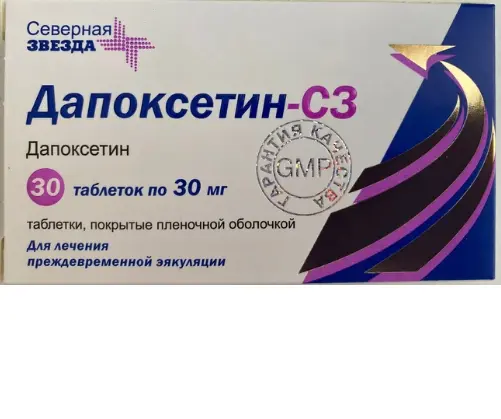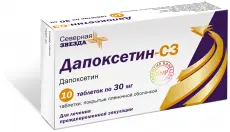Description
Dapoxetine Pharmacodynamics
Dapoxetine is a potent selective serotonin reuptake inhibitor (SSRI) with a half-maximal inhibition concentration (IC50) of 1.12 nM, metabolized in the body to the major metabolites, desmethyldapoxetine (IC50 < 1.0 nM) and didesmethyldapoxetine (IC50 = 2.0 nM), equally or less active (dapoxetine-N-oxide (IC50= 282 nM)).
The mechanism of action of dapoxetine in premature ejaculation is associated with inhibition of serotonin reuptake by neurons followed by enhancement of neurotransmitter action at pre- and postsynaptic receptors.
The mechanism of ejaculation is regulated mainly by the sympathetic nervous system. In rats, postganglionic sympathetic nerve fibers innervate the seminal vesicles, the vas deferens, the prostate, and the urethral and bladder neck muscles, causing their coordinated contraction to achieve ejaculation. Dapoxetine affects the ejaculation reflex at the supraspinal level in the lateral parahygantocellular nuclei by increasing the latent period and decreasing the duration of the reflex impulse of the motoneurons of the perineal ganglia. The stimulus triggering ejaculation is generated in the spinal reflex center, which is controlled through the brain stem by several brain nuclei, including the preoptic and paraventricular ones.
Indications
Dapoxetine-SZ is indicated for the treatment of premature ejaculation in men aged 18 to 64 years.
Dapoxetine-SZ may only be used in patients who meet the following criteria:
– Intravaginal ejaculation delay time (IVCE) < 2 minutes;
– persistent or regularly occurring ejaculation after minimal sexual stimulation before, during, or shortly after sexual penetration, and occurring before the patient’s desired moment;
– Severe personal distress or difficulties in interpersonal relationships due to premature ejaculation;
– poor ejaculation control;
– occurrence of premature ejaculation in most attempts at intercourse in the past 6 months.
Dapoxetine-SZ should only be used as required prior to intended sexual activity. Dapoxetine-SZ should not be used to delay ejaculation in men without a confirmed diagnosis of premature ejaculation.
Contraindications
– Hypersensitivity to dapoxetine and/or any excipient in the drug.
– Severe heart disease (e.g., chronic heart failure NYHA class II-IV, cardiac conduction disorders (atrioventricular conduction block or sinus node weakness syndrome); diagnosed coronary heart disease; heart valve disease.
– Concomitant use of monoamine oxidase inhibitors (MAOIs) and administration of dapoxetine for 14 days after discontinuation of the MAOI inhibitor. Accordingly, MAOI inhibitors should not be taken within 7 days after discontinuation of Dapoxetine-SZ.
– Simultaneous use of thioridazine and for 14 days after discontinuation of its use. Accordingly, thioridazine should not be taken within 7 days after discontinuation of Dapoxetine-SZ.
– Concomitant administration of selective serotonin reuptake inhibitors (SSRIs); serotonin reuptake inhibitors, norepinephrine and tricyclic antidepressants; other drugs with serotoninergic effects (e.g,
L-tryptophan, triptans, tramadol, linezolid, lithium, Hypericum perforatum preparations) and for 14 days after discontinuation of these drugs. Accordingly, these drugs should not be taken within 7 days after discontinuation of Dapoxetine-SZ.
– Simultaneous use with strong CYP3A4 inhibitors, such as ketoconazole, itraconazole, ritonavir, saquinavir, telithromycin, nefazodone, nelfinavir, atazanavir, etc.
– In patients with moderate to severe hepatic impairment.
– In patients with severe renal insufficiency.
– In patients under the age of 18 years and over 64 years (due to the lack of data on the efficacy and safety of dapoxetine in these patient populations).
– Lactose intolerance, lactase deficiency, glucose-galactose malabsorption syndrome.
– History of syncope.
– A history of manic state or severe depression.
– In the presence of diagnosed or suspected orthostatic hypotension.
– Dapoxetine-SZ should not be used in patients with mania/hypomania or bipolar disorder.
With caution
– in patients with mild to moderate renal impairment;
– concomitant use with strong CYP2D6 isoenzyme inhibitors and CYP3A4 medium inhibitors in patients with genotypically low CYP2D6 isoenzyme activity and patients with high CYP2D6 isoenzyme activity (in combination with CYP3A4 medium inhibitors)
– concomitant use with drugs that affect platelet aggregation and anticoagulants because of the risk of bleeding, as well as in patients with a history of bleeding or coagulation disorders.
Use during pregnancy and breastfeeding
Dapoxetine-SZ is not intended for use in women.
Animal studies have shown no direct or indirect adverse effects on fertility, pregnancy or embryo/fetal development.
How to use and dosages.
- Oral. The tablet should be swallowed whole with at least one full glass of water. Dapoxetine-SZ may be taken regardless of meals.
- Do not start with a dose of 60 mg.
- Adult men 18 to 64 years of age
The recommended starting dose for all men is 30 mg; this dose is taken 1 to 3 hours before the intended sexual intercourse. If the 30 mg dose is inadequate and well tolerated (no moderate to severe adverse reactions or prodromal symptoms that may precede syncope), the dose may be increased to the maximum recommended 60 mg taken
1 to 3 hours before sexual intercourse. The frequency and severity of adverse reactions are increased when the 60 mg dose is taken. - Patients in whom taking Dapoxetine-SZ in a dose of 30 mg is accompanied by symptoms of orthostatic hypotension should not increase the drug dose to 60 mg. The drug should not be taken more than once a day. The maximum daily dose with good tolerance is 60 mg.
- The physician prescribing Dapoxetine-SZ for treatment of premature ejaculation should assess the risks and benefits of the drug after the first 4 weeks of treatment or at least after the first 6 doses and determine the risk-benefit ratio for deciding whether to continue treatment with Dapoxetine-SZ.
- There are limited data on the efficacy and safety of dapoxetine over 24 weeks. The clinical necessity of continued therapy and the benefit/risk ratio of Dapoxetine-SZ should be assessed at least every 6 months.
- Patients with impaired renal function
No dose adjustment is required for patients with mild to moderate renal impairment, but caution is recommended. Dapoxetine-SZ is not recommended for patients with severe renal impairment. - Patients with hepatic impairment
Dapoxetine-SZ is contraindicated in patients with moderate to severe hepatic impairment (Child-Pugh grades B and C). - Elderly patients (65 years and older)
The efficacy and safety of dapoxetine in patients 65 years of age and older have not been established. - Patients with low CYP2D6 isoenzyme activity and patients simultaneously taking strong CYP2D6 inhibitors
Caution should be exercised when increasing the dose of Dapoxetine-SZ to 60 mg in patients with low CYP2D6 isoenzyme activity or in patients taking Dapoxetine-SZ simultaneously with strong CYP2D6 isoenzyme inhibitors. - Patients receiving strong or moderately active CYP3A4 isoenzyme inhibitors
Simultaneous use of Dapoxetine-SZ with strong CYP3A4 isoenzyme inhibitors is contraindicated. When concomitant use of Dapoxetine-SZ with moderately active CYP3A4 isoenzyme inhibitors, the drug dose should be reduced to 30 mg, and in this case, care should also be taken.


